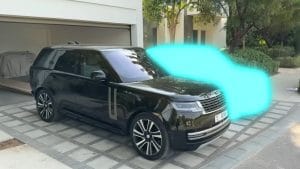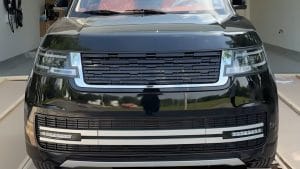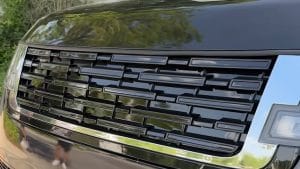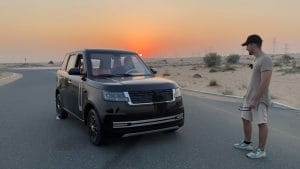Unveiling the Hype: Why a $4000 Chinese Range Rover Turned Heads. When news of a $4000 Chinese-made Range Rover hit the headlines, it sparked skepticism and intrigue across automotive circles. This vehicle, produced by a lesser-known manufacturer, doesn’t just mimic the iconic British SUV—it attempts to deliver luxury aesthetics at an almost unimaginable price point. The buzz surrounding this model stems largely from its audacious goal: to bring premium features to a budget-conscious market, a feat rarely seen in the automotive industry.
One of the main talking points is its design. The $4000 Chinese Range Rover borrows heavily from the sleek and commanding body lines that have made the original Range Rover a global status symbol. From the sharply sculpted headlights to the muscular grille, the attention to exterior detail is striking for a vehicle at this price. This uncanny resemblance has led some observers to refer to it as a “budget twin” of the premium SUV.
The interior has also contributed to the hype. While the genuine Range Rover offers high-end leather, polished wood, and advanced technology, the budget version swaps out luxury materials for cost-effective alternatives like synthetic leather and plastic trims. Surprisingly, its cabin still incorporates desirable features such as a touchscreen display, imitation wood finishes, and a panoramic sunroof—all rare findings in cars below this price segment. The result is a vehicle that, at first glance, feels far more expensive than it is.

The price tag turns heads for practical reasons as well. At $4000, most buyers expect nothing more than a basic, stripped-down commuter car. Instead, this Chinese Range Rover offers sporty styling, higher ground clearance resembling an SUV, and a promise of adventure-ready versatility. This model has created significant discussion for families or individuals aspiring to own a visually commanding vehicle but operating within a tight budgetsWANTS40:11 I26:43 Toyotaer, questions remain about its performance and long-term reliability. Armed with a compact engine and modest power output, it isn’t a competitor for the true Land Rover regarding off-road capability or driving dynamics. But for urban environments and light suburban commutes, it promises sufficient usability. Many wonder if the build quality and engineering can live up to international standards or whether compromises were made to cut costs.
The $4000 Chinese Range Rover has, without a doubt, disrupted expectations around what budget vehicles can offer. It serves as a bold example of how perceived luxury can be democratized—albeit in an unconventional package. Entrepreneurs and car enthusiasts alike continue to dissect this curious offering, trying to understand its implications for the global automotive market.
First Impressions: The Packaging and Initial Aesthetic Review
Unboxing a $4000 Chinese Range Rover clone begins with its packaging, which is a key element in forming early impressions. The box arrives with a sturdy exterior, featuring minimal branding but boasting export certifications prominently displayed. The choice of simple but industrial-grade packaging materials demonstrates a balance between keeping costs low and ensuring the product’s safety during international transit. Layers of foam padding closely hug the contents inside, offering a sense of care in preventing damage.
The moment the outer box is opened, attention shifts to the first glimpse of the vehicle itself. The clone is protected further by a dustproof cover, shielded as though it were a much higher-tier product. While not luxurious, the effort put into safeguarding the components inside is evident. Upon removing the protective layers, the overall design immediately catches the eye. The vehicle mimics the iconic Range Rover silhouette, with sleek, angular contours and a design language strikingly similar to its luxury inspiration.

Details such as the placement of logos, grille design, and headlamp outlines suggest a deliberate attempt to echo premium aesthetics. However, closer inspection reveals subtle disparities. The body panels appear slightly less refined, with occasional uneven gaps between edges. The paint finish, while glossy enough to command attention, lacks the depth and mirror-like quality associated with higher-end vehicles.
The experience of unveiling continues to provoke curiosity. Alloy wheels with a sporty finish add to the aesthetic appeal, though the branding on tires hints at lower-tier suppliers. The plastic trim pieces, while eye-catching at first glance, seem to lack the tactile richness of their luxury counterparts. The unpacking process emphasizes an effort to offer a premium-inspired feel within budget constraints, giving viewers plenty to observe at first glance.
Design and Build Quality: A Closer Look at the Craftsmanship
The $4000 Chinese Range Rover immediately impresses with its bold design language, which borrows heavily from the luxury SUV bearing the same name. Its exterior showcases carefully sculpted lines, a large grille that mimics the original’s iconic look, and sleek LED headlights that provide a modern touch. The proportions are strikingly similar to its premium counterpart, leaving an unmistakable first impression for onlookers. Despite the budget-friendly price, many of the design elements are surprisingly polished.
Closer inspection of the materials reveals a mixture of high-end aesthetics and cost-conscious decisions. The body panels feel robust, with an even paint application that suggests commendable attention to detail. However, certain areas reveal compromises, such as the use of lower-grade plastics for trim pieces in places less visible, like the underbody cladding or wheel arches. These choices ensure costs remain low while maintaining exterior appeal.

Inside the cabin, the blend of luxury inspiration and affordability becomes even more apparent. The dashboard features a layout reminiscent of high-end SUVs, with a touchscreen infotainment system prominently placed in the center. The faux leather upholstery feels soft and visually rich, providing a premium look, though its durability remains questionable. Controls and knobs, while functional, reveal some cost-cutting with their lightweight construction and occasional stiffness.
Overall fit and finish exhibit both strengths and weaknesses. Panels align neatly in some areas, while others show small gaps that detract from the overall refinement. The stitching on the seats and steering appears tidy, but the tactile feel of buttons and handles does not entirely meet the design’s upscale ambitions. These small inconsistencies, while expected at this price point, highlight the balancing act between style and substance.
Under the Hood: Examining the Engine and Performance Specs
Beneath the sleek exterior of the $4000 Chinese Range Rover lies a surprisingly unconventional powertrain setup, designed to achieve cost efficiency while maintaining basic functionality. The engine, a small displacement turbocharged four-cylinder, offers a modest power output typically hovering around 100 to 120 horsepower. While this pales in comparison to the robust engines found in a genuine Range Rover, it is sufficient to meet the needs of urban commutes and light driving conditions.
The compact engine is paired with either a 5-speed manual gearbox or a rudimentary automatic transmission. The transmission, while serviceable, lacks the refinement expected in luxury vehicles, occasionally delivering jerky shifts under load. This drivetrain combination supports front-wheel-drive configurations in most models, with some higher-end variants offering an all-wheel-drive option designed primarily for navigating slippery roads rather than serious off-roading.

Fuel efficiency is a priority here, as the model boasts consumption rates ranging between 30 to 35 miles per gallon, a notable achievement given its SUV classification. This focus on economical operation comes at the expense of speed and acceleration, with 0 to 60 mph times averaging an uninspiring 12 to 14 seconds. The top speed caps just above 100 mph, further underlining its utilitarian rather than performance-oriented nature.
Suspension and handling are standard fare, with MacPherson struts up front and a torsion beam rear axle setup. While not engineered for rugged terrain or dynamic cornering, it delivers a passable ride for everyday driving. Braking is managed by a disc-and-drum combination, allowing for adequate stopping power despite its budget construction.
Interior Features: Luxury or Letdown?
Stepping into the cabin of the $4000 Chinese Range Rover clone is an experience that creates mixed impressions. At first glance, the interior boasts an ambitious design, clearly inspired by its luxury counterpart. Faux leather seats, stitched dashboards, and a panoramic sunroof create the illusion of upscale elegance. However, a closer inspection reveals the compromises made to achieve the low price point.
The seating, while soft enough for short rides, lacks proper lumbar support and cushioning for extended drives. The promise of a “high-tech” infotainment system is undermined by its slow responsiveness and outdated graphics. Though the touchscreen appears sleek, its functionality is hindered by frequent glitches, making navigation and media controls frustrating. Audio quality also leaves much to be desired, often sounding muffled and underwhelming compared to premium systems.

Key interior features include an array of seemingly modern conveniences such as a digital instrument cluster, ambient lighting, and USB charging ports. Yet, the materials used feel plasticky, and buttons and knobs lack the tactile feedback associated with luxury vehicles. Attention to detail appears inconsistent—air vents wobble, and some trim pieces appear poorly fitted.
On the plus side, the vehicle offers decent interior space, with rear passengers benefiting from reasonable legroom and headroom. Storage options are functional, providing ample room for everyday items. However, when measured against true luxury competitors, the interior feels more like an imitation than a rival.
Overall, the cabin walks a fine line between appearing luxurious and revealing its budget roots. For buyers prioritizing style over substance, it might suffice; for others, the shortcomings may be hard to ignore.
How It Stacks Up: Comparing It to the Real Range Rover
At first glance, the $4000 Chinese Range Rover replica does an admirable job of replicating the iconic SUV’s design cues. The exterior features a similarly sleek silhouette, complete with a distinct grille pattern and headlights that mimic the luxury vehicle’s signature look. However, closer inspection reveals notable differences in build quality. The replica uses cheaper materials, with plastic trims that lack the refinement of the polished metals and high-end composites found in genuine Land Rovers.
The interior tells a similar story. Where the real Range Rover boasts leather upholstery, wood veneer accents, and polished chrome finishes, the Chinese version substitutes synthetic fabrics, faux wood, and flimsy hardware. The dashboard layout attempts to mirror the real Range Rover but lacks the meticulous stitching and tactile luxury of its inspiration. The infotainment system is also significantly scaled down, missing many high-tech features like premium navigation options, advanced driver assistance systems, and immersive sound systems.

Performance is another area where the differences are stark. The original Range Rover is renowned for its superior all-terrain capabilities, featuring powerful engine options and sophisticated suspension systems. In contrast, the Chinese version equips a much smaller engine, leading to modest horsepower, limited towing capacity, and a lack of off-road prowess. The suspension, while functional for city driving, fails to deliver the smooth, adaptive handling that Range Rover owners expect.
From a safety standpoint, the replica also lacks the extensive suite of features, including adaptive cruise control, lane-keeping assist, and robust crash-test certifications, that the luxury SUV incorporates. While the Chinese version serves as an entry-point vehicle for some, comparing it to the genuine Range Rover highlights the significant gaps in quality, performance, and advanced engineering.
Test Drive: Experiencing the Ride Firsthand
Sliding behind the wheel of the $4000 Chinese Range Rover, one is greeted with a cabin that is surprisingly well-appointed for its price point. The materials, while not quite at the level of genuine luxury automobiles, offer a mix of soft-touch plastics and faux-leather upholstery. The seating is comfortable, with decent lumbar support, though taller individuals may find the legroom slightly lacking. Visibility from the driver’s seat is adequate, thanks to the vehicle’s elevated stance and broad windshield.
Upon ignition, the engine springs to life with a noticeable hum. The sound insulation, while passable, does allow engine noise to seep into the cabin during acceleration. On city roads, the car handles itself capably, with steering that feels moderately responsive, though it leans toward the lighter side. Maneuvering in tight spaces is aided by a rearview camera that, although functional, lacks the crispness found in higher-end vehicles.

On open highways, the car struggles to match the refinement of premium SUVs. The engine’s output feels underwhelming with a slight delay in throttle response, particularly during overtakes. The suspension system provides a reasonably smooth ride on flat roads, but uneven surfaces are more noticeable due to limited damping. Stability at higher speeds is adequate, though there is a modest degree of body roll during sharp turns.
A few thoughtful touches elevate the driving experience. Features like a touchscreen display, though basic in design, integrate well with standard functions like navigation and Bluetooth connectivity. Climate control is intuitive and effective, adding to driver and passenger comfort. While testing the brakes, the stopping distance proved acceptable, although the pedal feel could be more refined.
Despite its limitations, the vehicle impresses with its affordability and ambition — an intriguing blend of functionality and minimalist charm.
Durability Concerns: Is It Built to Last?
When investing in a $4000 Chinese Range Rover lookalike, durability quickly becomes a point of contention. At this price point, the initial focus is often on the impressive styling and luxury features, but questions about build quality and longevity naturally arise. A closer inspection reveals several areas where potential durability concerns may lurk.
Materials and Build Quality
The vehicle’s exterior finish may be visually appealing, but the quality of the materials tells a different story. Many owners report that cheaper plastics are used in parts such as door panels, dashboards, and wheel trims. Over time, these materials are prone to cracking, fading, or warping, especially in extreme weather conditions. Similarly, the paintwork is often described as thinner compared to that of more premium alternatives, making it susceptible to scratches and chips.
Engineered Components
The mechanical components, including the engine and transmission, appear to be designed with cost-saving in mind. Common issues cited by users involve premature wear to engine mounts, subpar suspension performance, and weak seals that can lead to oil leaks. This raises concerns about whether the vehicle will withstand years of extended use. Moreover, the cheaper drivetrain components have been known to produce unusual noises as the mileage climbs.
Fasteners and Joints
Another key consideration is the strength of joints, hinges, and fasteners. Reports suggest that certain areas, such as the hinges on doors and the tailgate, may not hold up under continuous stress. This could lead to alignment issues or even structural weakness over time. Interior fittings, such as seat mounts and dashboard fasteners, have also been flagged for their fragility.
Electrical Systems
The electrical systems, particularly infotainment and control modules, have garnered mixed feedback. Some vehicles experience early malfunctions in touchscreen displays or driver-assist technologies. Additionally, wiring harnesses could be less robust, increasing the likelihood of shorts or disconnections due to vibrations or environmental factors.
While the initial appearance of the vehicle may impress, the underlying build quality invites skepticism about its ability to endure the test of time.

The Cost Breakdown: What Are You Paying For?
Unboxing a $4000 Chinese Range Rover clone prompts immediate curiosity about where the money has been allocated. A closer look reveals that this isn’t merely a bargain; it’s a calculated balance of features, materials, and engineering compromises.
1. Exterior Design and Build Quality
A significant portion of the budget appears to be spent mimicking the premium SUV’s aesthetic appeal. From the meticulously designed front grille to the LED lighting setup, the exterior leaves an impression reminiscent of its luxury counterpart. However, beneath the surface, lightweight materials, thinner paneling, and fewer reinforced components become apparent, reducing production costs. Paint quality, while shiny at first glance, may lack the durability and scratch resistance of pricier models.
2. Interior Features and Comfort
Step inside, and it’s evident where expenses were trimmed. The cabin showcases synthetic leather upholstery, a passable imitation of genuine hides. While the dashboard boasts a modern touchscreen and digital gauges, these components often feature slower interfaces and less responsiveness compared to their high-end inspirations. Cost-conscious seating adjustments and basic climate controls further highlight the trade-offs in comfort mechanisms.
3. Engine and Performance Systems
Delving under the hood unveils an efficient but underpowered engine. Low-cost manufacturing and simpler engineering result in reduced power and performance compared to traditional luxury SUV standards. The suspension system, while functional, lacks the refinement needed for top-tier ride quality. Instead of dynamic driving modes, the drivetrain typically offers a no-frills setup geared toward city commutes rather than off-road excursions.
4. Technology and Safety
The technology suite includes essentials like a basic backup camera and Bluetooth but skips high-end additions such as advanced autonomous driving features. Similarly, safety systems often focus on barebones compliance rather than state-of-the-art innovation, lacking features like adaptive cruise control or lane-keeping assist. Cheaper sensors and limited software capabilities are common.
5. Production and Labor Costs
Manufacturing in regions with lower labor costs is another defining factor. Streamlined production processes and widespread utilization of generic components allow companies to drastically reduce retail prices. Yet, this can mean less stringent quality control, riskier supply chain reliability, and shorter product lifespans.
Through each element, the allocation of the $4000 price tag becomes clear. While it delivers visual appeal and essential utility, buyers must weigh these savings against potential sacrifices in longevity, efficiency, and functionality.
Final Thoughts: Does the $4000 Chinese Range Rover Live Up to the Hype?
The $4000 Chinese Range Rover, often touted as an affordable alternative to the luxury SUV segment, positions itself as an intriguing option for budget-conscious buyers. At first glance, its exterior design is undeniably inspired by its high-end counterpart, with sleek lines, a bold grille, and LED accents that mimic the sophistication of premium SUVs. The craftsmanship, while visually impressive from a distance, reveals inconsistencies upon closer inspection. The materials used, particularly in the body panels and trim, may not carry the durability seen in more expensive models.
Stepping inside, the interior attempts to blend style with practicality. It features a touchscreen infotainment system, leather-look seats, and a modern dashboard layout that appeals to tech-savvy drivers. However, closer examination reveals that the infotainment software tends to lag, and the fit and finish of interior elements lack refinement. The seating provides adequate comfort for short commutes, though longer drives may highlight discomfort and limited support.
When it comes to performance, the SUV delivers mixed results. Equipped with a small engine designed for fuel efficiency, it struggles to provide the agility or acceleration expected of an SUV. Drivers may notice strained engine sounds or less-than-smooth gear shifts when navigating varied terrains. That said, it manages to perform reasonably well in urban settings, where speed limits are moderate, and the demands on suspension and drivetrain are minimal.
Perhaps one area where the vehicle stands out is its affordability. Its price point, a fraction of what luxury SUV competitors demand, allows buyers to access the appearance of a high-end SUV without breaking the bank. However, compromises in build quality, reliability, and performance may prompt potential owners to weigh the long-term investment carefully.








